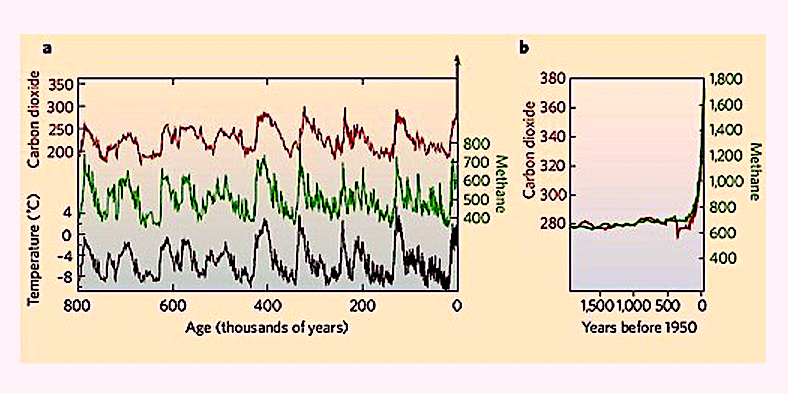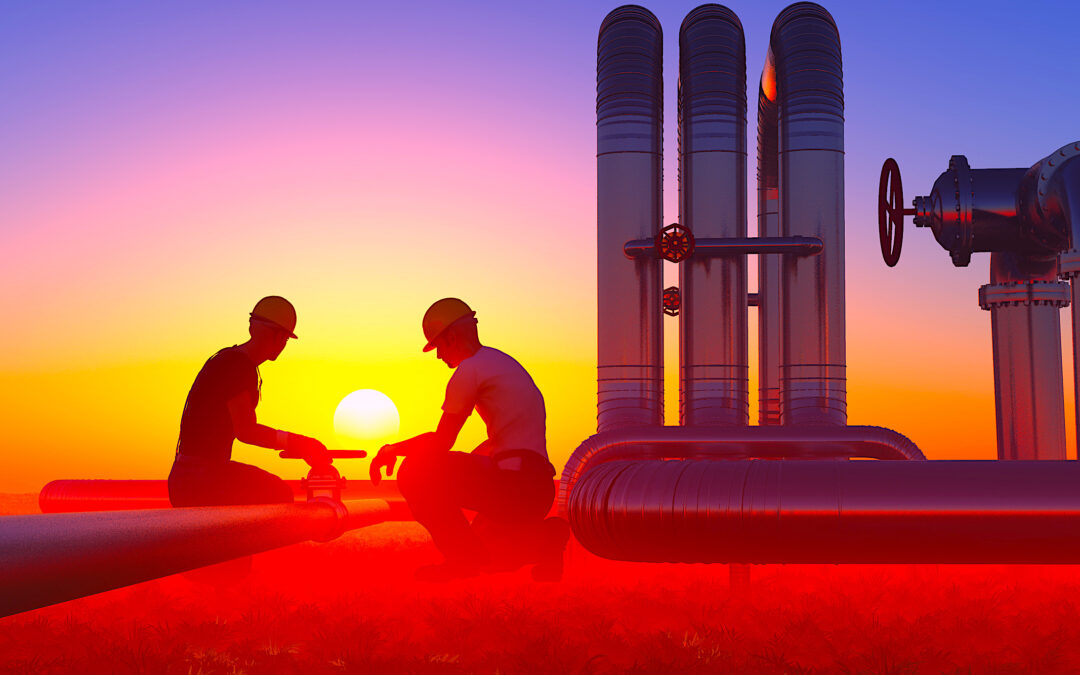From a climate change perspective, carbon dioxide (CO2) gets all the press. But methane (CH4), the primary component of natural gas, is growing at a faster rate than CO2, and control of it is much more attainable in the near term. As a greenhouse gas (GHG), methane is 80 times more powerful in its first 20 years of life. The primary sources of emissions are agricultural and Oil & Gas operations. Most of the fugitive emissions in the Oil & Gas sector come from “super emitters,” meaning that by eliminating a few large methane leaks, we can have a big, short-term impact.
Geochemists have carefully analyzed ice in core samples from about 800,000 years ago. During that period, CO2 averaged 225 parts per million (ppm), with an historic high of 300 ppm. With the dawn of the industrial age, though, CO2 levels began to soar. Today, CO2 levels sit at 419 ppm.
Methane, on the other hand, as shown in those ancient ice-core samples, averaged about 500 parts per billion (ppb) with a historic high of 800 ppb, which occurred about 340,000 years ago. Since the start of the industrial age, however, atmospheric methane has increased from that previous historic average of 500 ppb to 1,893 ppb today. While CO2 levels have nearly doubled during the industrial age, atmospheric methane has nearly quadrupled during the same period. [Moore] See figure below.
 Historic levels of atmospheric CO2 and methane on the left
Historic levels of atmospheric CO2 and methane on the left
and more recent levels in the graph on the right (Moore, 2008).
A big difference between rising levels of atmospheric CO2 and methane is what we can do about them in the short term. While not formally a noble gas, CO2 behaves like one (essentially chemically inert and nonreactive). It must be eliminated by uptake (e.g., trees consume CO2 as a part of photosynthesis). But, because CO2 is emitted from so many sources, we must materially change social and human behavior to slow its growth in our atmosphere. That’s something we, as a society, absolutely must do, but it’s a long-term proposition. Methane emissions we can address in the near term
Aside from natural emissions, methane has two major anthropogenic sources: belching of ruminant animals like cattle, and fugitive emissions from Oil & Gas operations. We can control these emissions in the near term by changing our diets and curing leaks in oil and gas production, gathering and boosting, processing, transmission, storage, and pipeline and distribution operations.
The best estimate for fugitive-methane emissions is 3.2% of total production. Think about that for a moment. The natural-gas industry in the United States is a $135-billion-per-year behemoth. At a 3.2% leakage rate, which may be conservative, the Oil & Gas sector is leaking $4.3 Billion in pure profits because all associated costs up to the point of the leak are sunk. Moreover, the energy and equipment used to produce, process, transmit, store, and distribute natural gas is leaked away, too, which only compounds the wasteful losses.
Fortunately, between infrared cameras and airborne-ultrasonic-analysis techniques, we can easily find fugitive methane emissions. And, if we can find them, we can fix them. Most leaks occur at valves and flanges. Fixing the leaks is a rather pedestrian task. So, let’s get busy, Oil & Gas industry: Let’s employ sensible leak detection and repair (LDAR), quit leaking profits, and reduce the deleterious environmental impacts of our leaked methane.TRR
REFERENCE
Moore, L. (2008) Highest CO2 and Methane in 800,000 Years. Environmental Defense Fund (EDF) Blog.
ABOUT THE AUTHOR
Drew Troyer has over 30 years of experience in the RAM arena. Currently a Principal with T.A. Cook Consultants, he was a Co-founder and former CEO of Noria Corporation. A trusted advisor to a global blue chip client base, this industry veteran has authored or co-authored more than 300 books, chapters, course books, articles, and technical papers and is popular keynote and technical speaker at conferences around the world. Drew is a Certified Reliability Engineer (CRE), Certified Maintenance & Reliability Professional (CMRP), holds B.S. and M.B.A. degrees. Drew, who also earned a Master’s degree in Environmental Sustainability from Harvard University, is very passionate about sustainable manufacturing. Contact him at 512-800-6031, or email dtroyer@theramreview.com.
Tags: reliability, availability, maintenance, RAM, environmental safety and health, sustainability, greenhouse gas, GHG, carbon dioxide, CO2, methane, CH4, fugitive emissions, infrared cameras, airborne-ultrasonic analysis



